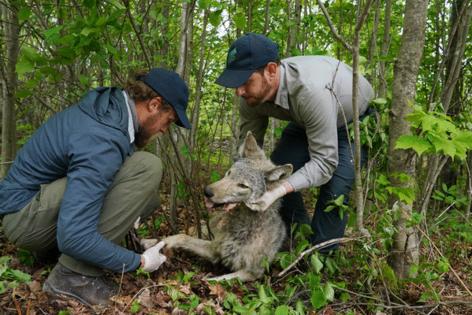Gray wolf numbers fall to their lowest level in a decade in far northern Minnesota
Published in News & Features
MINNEAPOLIS — A string of mild winters and scarce deer may have taken their toll on northern Minnesota’s wolves.
The wolf population in and around Voyageurs National Park dropped to roughly 100 this year, its lowest point in more than a decade, according to an annual survey from the Voyageur’s Wolf Project.
Researchers estimated there were 45 wolves per 1,000 square-kilometers in the woods around Voyageurs, down from 55 in 2024 and 65 in 2023.
The dip is part of the natural ebb and flow between predator and prey, said Tom Gable, the project lead of the Voyageurs Wolf Project.
The wolf population in the area is still healthy and will likely climb again as deer numbers rebound, he said.
“It follows a fairly typical pattern,” he said.
The winters of 2022 and 2023 were unusually severe in northern Minnesota, with deep snowpacks lasting well into spring. That snow, especially when it lingers into April and May, is tough on deer.
“Deer can weather deep snow for a month or two, but if it drags into spring it really starts to challenge them,“ Gable said.
That’s because they’ve already burned through most of their fat reserves to survive the winter. The snow makes it harder for them to move, requiring more energy to get around and evade wolves. Eventually, the deer become a relatively easy meal.
Gable said the deer population in the Voyageurs area was cut in half by the spring of 2023, following the two severe winters.
Mild winters, on the other hand, are extremely difficult for wolves. Without snow on the ground to slow them down, deer stay fast and energized and better able to elude predators. All other sources of food for the wolves, including beavers, fish and blueberries, are inaccessible. The wolves burn through their fat reserves by the spring and struggle to raise their pups.
The winter of 2024 was one of the mildest ever recorded in northern Minnesota. Another mild winter in 2025 brought very little snow, as well.
The Voyageurs Wolf Project, run by the University of Minnesota, has followed dozens of wolves since 2014 using GPS collars as well as several hundred trail cameras to track the size and behavior of more than 24 wolf packs that live and hunt in the area. The project is funded by the state’s environment and natural resources trust fund.
Minnesota has more wolves than any other state in the Lower 48 and is the only place in the United States outside of Alaska that never eradicated them.
The state’s wolf population has been stable since the 1990s, typically fluctuating between 2,400 and 3,000. The Minnesota Department of Natural Resources has not yet completed its 2025 population estimate.
Gable said he couldn’t say if wolf populations fell in other parts of the state as steeply as they did in the Voyageurs area.
The pattern may already be turning back in the wolves’ favor.
Deer numbers in the Voyageurs area jumped more than 10% in 2024, Gable said. Early signs show that deer numbers may have had an even bigger jump this year.
More deer in the woods means more food for the wolves, that is, so long as they get a little help from the snow.
_____
©2025 The Minnesota Star Tribune. Visit startribune.com. Distributed by Tribune Content Agency, LLC







Comments